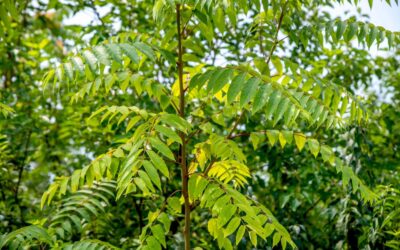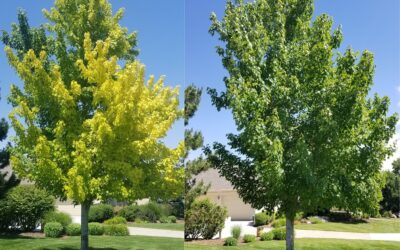If you want a tree that’s not only a showpiece to your landscape, but a conversation piece as well, the Espresso Kentucky Coffeetree is an excellent choice. It’s delicate yet large compound leaves give it an exotic, almost tropical appearance in the summer and when prepared properly, its seeds can be ground and brewed as a coffee substitute similar to chicory. Eat the seeds or leaves raw, though, and they’re poisonous. Fortunately, most wildlife has learned over time to avoid them so they’re basically deer-proof.
Growth, Size and Lifespan
The Espresso Kentucky Coffeetree grows quickly as a sapling, but is a slow grower in maturity.It tops out around 50 feet and spreads to about 30 feet so it should be planted away from power lines and other overhead obstructions. It’s high canopy, typically 6-7 feet at maturity, make it a good shade tree with plenty of sitting room under its branches. It’s a long-lived tree, too, with 90-100-year lifespans not uncommon.
Adaptable, Drought-Tolerant, Colorful and Disease-Free
The Kentucky Coffeetree should only be grown in full sunlight, but it adapts well to a wide range of soils and urban environments. Its drought tolerance makes it an ideal choice for shade in xeriscaping or other low moisture landscaping. It also leafs out late and drops leaves early, so that could be a plus for buildings that want to take maximum advantage of solar gain in cool climates while having shade in the hottest parts of the year.
Fall color ranges from bright to dull yellow and can vary year-to-year.
It’s largely disease-free and can be a good substitute for elm and ash trees that have been killed by pests and disease.
History and Propagation
Native to the northeastern U.S. and southeastern Canada, the Kentucky Coffeetree is considered an “evolutionary anachronism” by biologists. In prehistoric times, mastodons and other animals with powerful teeth could break the large, tough seed pods and distribute the seeds in their droppings. But when those animals became extinct, smaller creatures couldn’t get to the seeds (or maybe died if they ate them), so the naturalization of the tree diminished over time. But both the seeds (properly prepared) and the wood were highly prized by indigenous people, so they cultivated the trees, keeping the species alive. Since then, propagation has largely been done by tree growers.
The Espresso Kentucky Coffeetree has an interesting story. You can learn more about it from the USDA and other online sources. Or you can just plant it and enjoy it.
If you’re planning to add an Espresso Kentucky Coffeetree to your landscape, or have one that needs maintenance, call us at 303-623-8733 for a free estimate and to learn more about our complete planting, transplanting and tree removal services.



